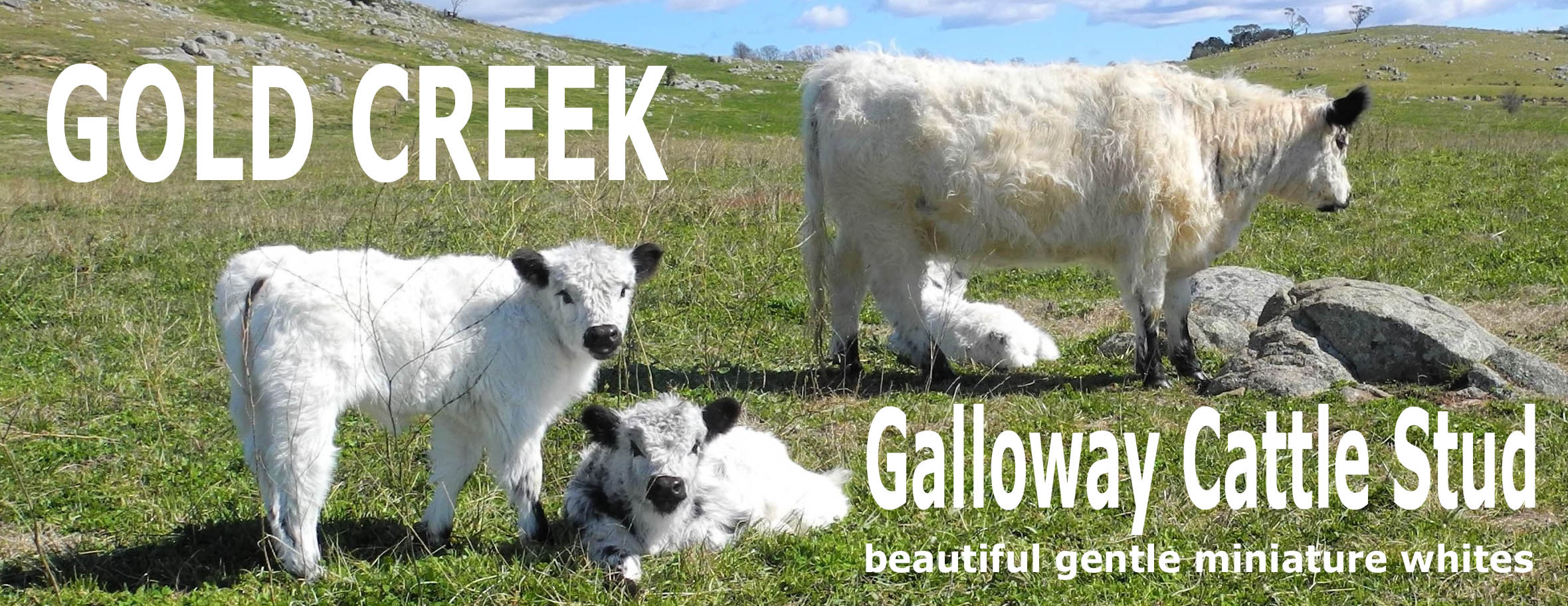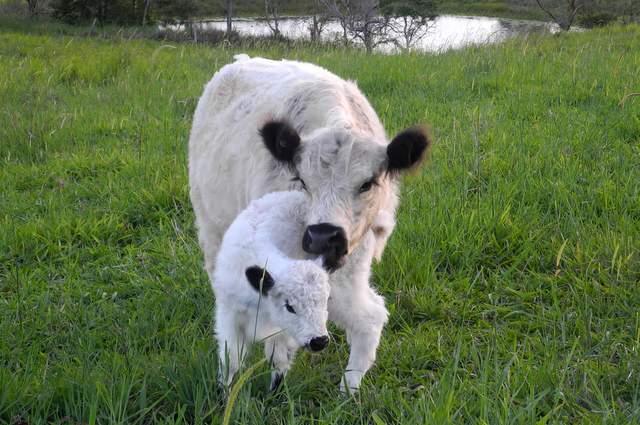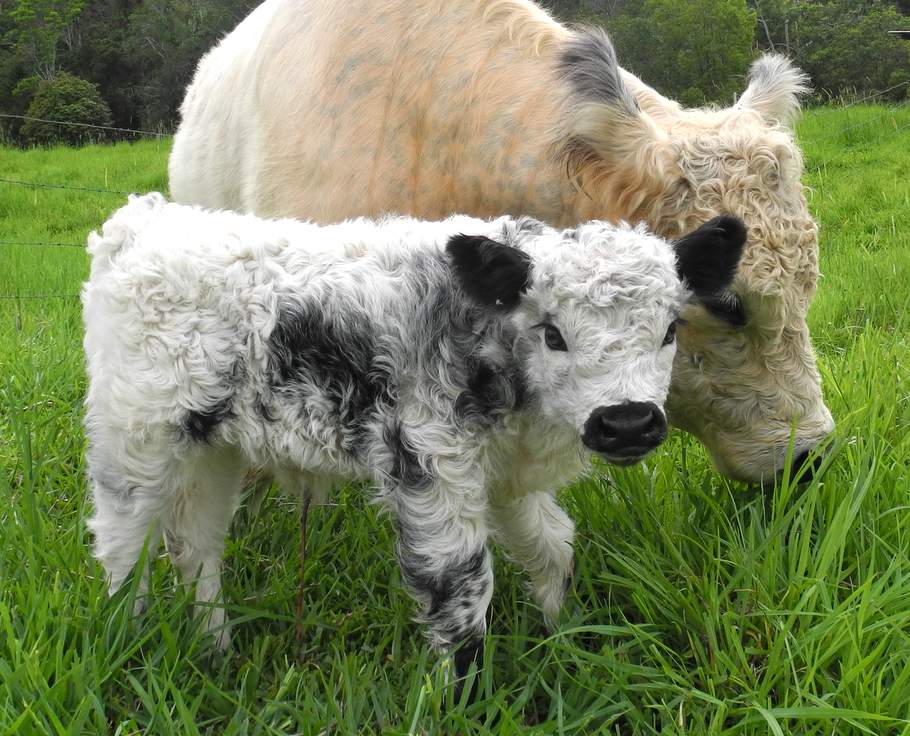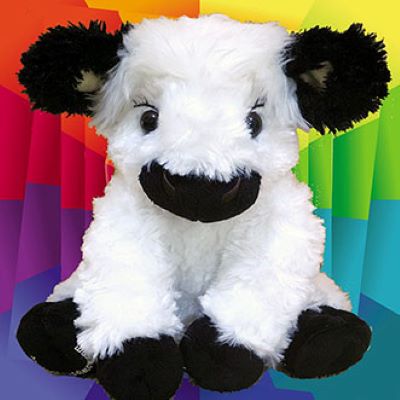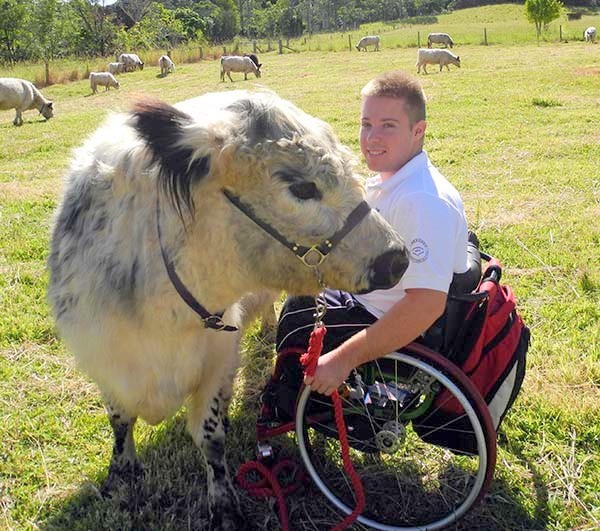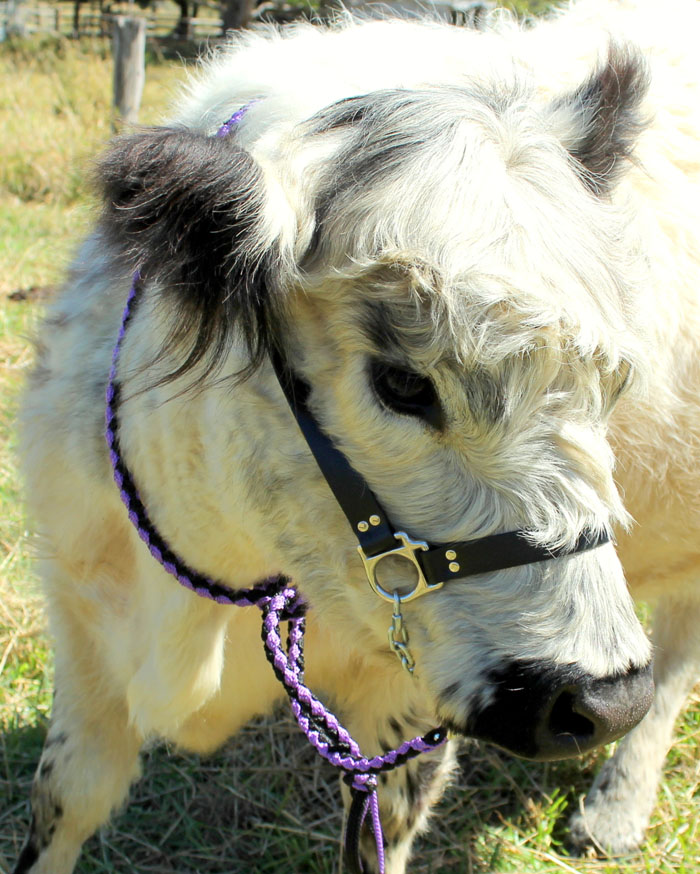There are three kinds of listed or registered Miniature White Galloway cattle in Australia - the full blood, purebred and grade Galloway cattle. All three play a valuable and legitimate role in the breeding of Galloway cattle - especially Miniature White Galloway graded cattle.
Three Kinds of Miniature White Galloways
The Full Blood Galloway: Full Blood Galloway cattle are registered cattle that have full blood Galloway cattle and only full blood Galloway cattle in their breeding history. No purebred Galloways, no grade Galloway or cattle of any other breed can appear anywhere in their breeding history.
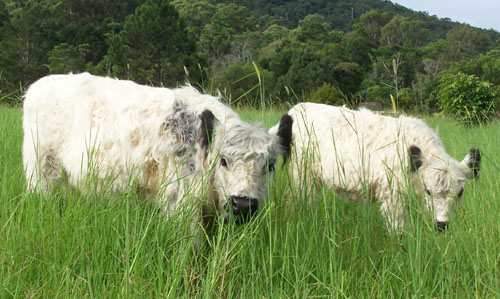
A full blood Miniature White Galloway heifer (left) from Colleen Smith at Oceanview Stud.
The Purebred Galloway: Purebred Galloway Cattle are Galloway cattle that have at least one other breed of cattle somewhere in their breeding history. Purebred Galloway cattle are different to full blood Galloway cattle. Purebreds have either been purposely bred by a breeder starting a grading-up programme, or they have animals in their breeding history that cannot be proven to be 100% full blood, Galloway.
An animal registered as purebred must be at least five generations removed from the original animal of a different breed. (If the animal from a different breed is less than five generations removed from that animal, then it will still be listed as a graded animal). To reach the purebred status in five generations, the progeny of each generation must be joined with a full blood bull or cow every time.

A purebred steer. A purebred bull was the sire - Glen Ayr Cannon Boy (AI).
The Graded Galloway: Graded Galloway cattle are cattle that have a breed of cattle, other than a Galloway, somewhere in their breeding history. When and where this other animal appears in their breeding history dictates the percentage of the Galloway grading given. From the first joining with a full blood Galloway, the progeny of a Hereford or Angus with a full blood Galloway, for example, can be listed or recorded as a 50% graded Galloway.
Why We Have Pure Bred and Graded Miniature White Galloways
The number of full blood Miniature White Galloways in Australia is small, and the bloodlines are limited. The numbers of purebred Miniature White Galloways in Australia is also small. Therefore, it is important that some breeders are prepared to take the time and do the work that is involved in breeding more purebred Miniature White Galloway cattle. This is where graded Miniature White Galloway cattle come into the picture.
Getting purebred cattle can be done in a number of ways. One way is to purchase a purebred Miniature White Galloway from someone else - easy. The other way is to breed one yourself - not so easy. This is done through grading up.
For a breeder to acquire purebred status, they can start with a base animal and a full blood Miniature White Galloway and grade up (the base animal being a cow or a bull from another breed altogether or an animal with less than 50% Galloway in its breeding). Or they can buy a graded Galloway and join it with a full blood Miniature Galloway and grade up. Then the breeder must hold onto the progeny of the joining and continue grading up.
Breeding a Purebred - The Grading up Process
Our breeding records are impeccable. All bulls used in any registered Galloway grading up breeding programme have to be DNA tested and their details recorded with the Australian Galloway Association. The breeding details of all females also have to be recorded. The cattle must test free of certain diseases. All cattle registered or recorded with the Australian Galloway Association are managed by the Agricultural Business Research Institute (ABRI) arm of the University of New England. These records cannot be altered by individual breeders.
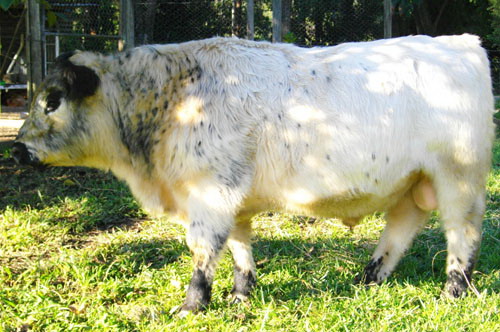
The first bull used in our programme Banjo - a cross. His breeding history and DNA profile are on record.
We had two heifer calves from Banjo. GOLD CREEK Sugar and GOLD CREEK Molly. They were small and sweet. Both heifers were joined with a full blood bull and sold. Both calved successfully for their new owners.
Cattle cannot be used in a breeding programme until they reach sexual maturity. Miniature bulls reach sexual maturity at around the 12-month mark and heifers at 14 - 16 months old. The age at which individual bulls and heifers are joined for the first time is a matter for the different breeders. Some breeders are confident to join them younger than others, and many have varying reasons for waiting until the cattle are older. Breeders may also decide that a particular animal is not going to remain in the breeding programme. The bottom line on the timeline of any grading up breeding programme is that there are a lot of variables that must be considered. The only thing you can be sure of is, that is going to take a lot of time.
The Five Generations
This will take a minimum of seven to eight years if all goes well!
1. Base animal (foundation animal with 0% or less than 50% Galloway) and a full blood Miniature White Galloway. First generation.
2. The Full Blood/base animal combination will give you a 50% Grade progeny. Two generations. (Time involved: 9-12 months. One year)
3. When this calf reaches sexual maturity, the 50% grade progeny of the first joining can be joined with a Full Blood. This combination will give you a 75% Grade progeny. Three generations. (Time: another 24 months minimum. At least three years from the start of the grading up breeding programme).
4. When this calf reaches sexual maturity, the 75% Grade progeny can be joined with a full blood. This joining will give you an 87.5% Grade progeny. Four generations. (Time: another 24 months. Five years from the start)
5. When this calf reaches sexual maturity, the 87.5% Grade progeny can be joined with a full blood. This joining will give you a 93.75% progeny a - Purebred. Five generations. (Time: another 24 months at least. Seven years from the start minimum).
Basically, if you are starting 'from scratch' you can expect it to take a minimum of seven to eight years if all goes well (and a whole lot longer if it doesn't). If you lose calves or get calves that you decide not to use in the breeding programme, for whatever reason, you lose valuable time.
Our GOLD CREEK Purebred Programme
We bought our first two full blood cows in 2006. One of the full blood cows we purchased was in fact in calf to Kazoo Gadget (unbeknown to the breeder or us). When the calf was born he was exceptionally small and sweet. The sire of this calf, Gadget was an extremely young, and very small 50% grade Miniature White Galloway bull. We quickly contacted the stud again. We were put in touch with the new owners of Gadget.
We visited the new owners. They showed us Gadget and his registration papers. Gadget was listed as a grade by the Australian Galloway Association. This was not important to us at the time, as we were just looking for an unrelated bull.
So, when our two full blood cows were ready to go back into calf, we used Gadget. Gadget sired GOLD CREEK Dougal to Glen Mist Ethereal. Dougal was a little beauty!
When our little bull Dougal reached sexual maturity, he was joined with Oceanview Dusty, Oceanview Cuddles and Castle Douglas Tinkerbell. We were really pleased to get three beautiful little heifer calves from these joinings.
The new owners of Gadget were not members of the Australian Galloway Association at the time, and we wondered if this might deem Gadget as inactive. We checked - it did not. Gadget's registration/listing papers were in order, and the Galloway Association gave us the go-ahead to list/register the details of all three heifers. GOLD CREEK Huggie, TwoDee and Tuppence. All three are listed as 87.5% graded Miniature Galloways. With an 87% grade, it meant that their calves, to a full blood bull, would be 93% and therefore deemed as purebred.
If you have any questions about our purebred cattle, please contact the Australian Galloway Association. They will gladly verify anything we have shared here.
1. GOLD CREEK Huggie, the first of our 87.5% grade heifers, was joined with our full blood bull Castle Douglas Nemo in 2013.
Huggie calved in January 2014. Her heifer calf GOLD CREEK Kismet is our first born and bred GOLD CREEK purebred 93%. We couldn't be happier with Huggie and her calf. Huggie calved unassisted. In 2015, Huggie weaned her heifer calf Kismet.
Huggie is giving little purebred Kismet a clean and a love up in January 2014.
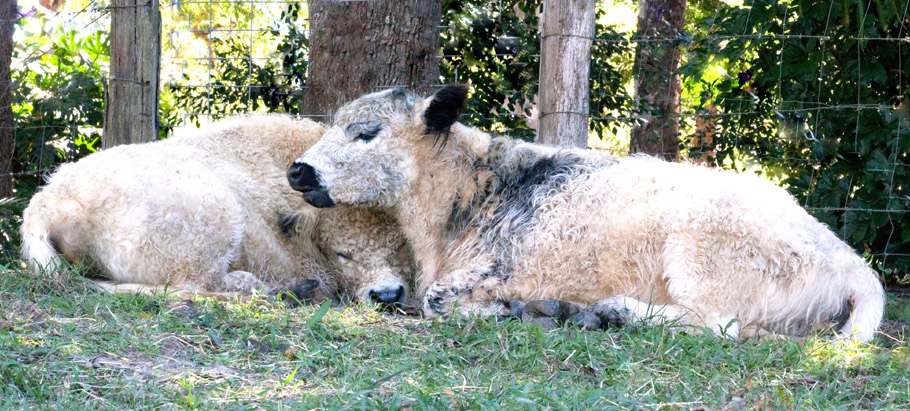
GOLD CREEK Dougal is enjoying a well-earned rest with Dusty in 2010. The conception of little TwoDee (pictured below) is the reason for all the exhaustion exhibited in this photo.
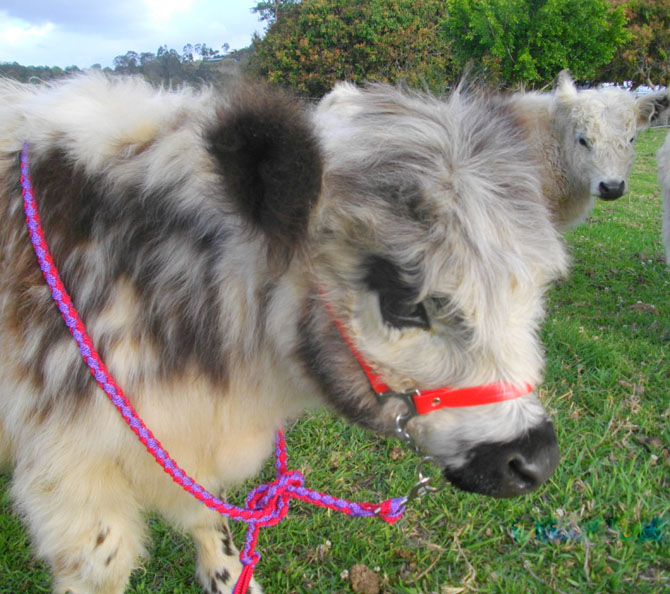
TwoDee an 87.5% heifer showing off her new halter during training (12 months old).
3. GOLD CREEK Tuppence was also from GOLD CREEK Dougal and a full blood Miniature White Galloway cow with strong black points. Tuppence inherited her softer ear colouring from Dougal. She also has his sweet nature, solid conformation and the ability just to just look at the grass and gain weight (a good thing for a cow.)
Tuppence joined with Nemo early in 2014, and she had GOLD CREEK Storm Boy just before Christmas 2014. Storm Boy is our second born and bred purebred Miniature White Galloway calf.
GOLD CREEK Tuppence, with her purebred bull calf, Storm Boy.
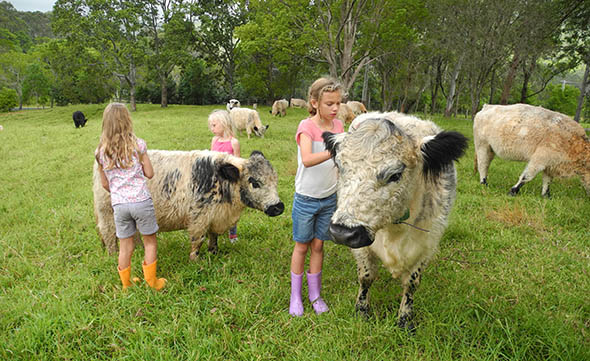
Dusty and TwoDee enjoying some attention in May 2013. Both are magnificent AAT cows.
Notice the matching 'shoulder pads' (splashes of black markings on the two getting attention above)? TwoDee inherited from her 'Mum' Dusty's colouring. We hoped that TwoDee's strong black points, solid little body and sweet nature carry through to her purebred calves too. Unfortunately, TwoDee did not get a chance to calve. She died one year after we moved to Braidwood. Losing her was heartbreaking.
Please note: Gadget only sired one calf registered/listed with the Australian Galloway Association. That calf was our beautiful GOLD CREEK Dougal. Dougal only sired three calves. We still have all three females and their calves. We have only sold one of the calves from the breeding programme involving GOLD CREEK Dougal because we can't bear to part with them. Gold Creek Storm Boy (grandson of Dougal) lives on a small farm near the Snowy Mountains in NSW.
